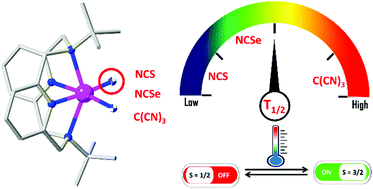Tuning of spin crossover properties in a series of mononuclear cobalt(ii) complexes based on a macrocyclic tetradentate ligand and pseudohalide coligands†
Abstract
The three mononuclear cobalt(II) complexes, [Co(L)(NCX)2] (L = N,N‘-di-tert-butyl-2,11-diaza[3,3](2,6)pyridinophane, and X = S (1), Se (2), and [C(CN)2] (3)), have been synthesized and characterized using variable temperature single-crystal X-ray crystallography, and spectroscopic, magnetic, and electrochemical studies. All three complexes have a similar distorted octahedral CoN6 coordination geometry produced by the macrocyclic tetradentate ligand L and two NCX− co-ligands in the cis position. Complexes 1 and 2 crystallized in the monoclinic P21/n (Z = 4) space group, while complex 3 was isolated in the monoclinic P21/c (Z = 4) space group. Interestingly, complexes 1 and 2 exhibit a reversible and gradual spin-crossover behavior between the high-spin (S = 3/2) and low-spin (S = 1/2) states at ca. 168 K and 255 K, respectively. However, for complex 3, a low-spin configuration persists up to 260 K and it exhibits an incomplete and reversible spin crossover even at 400 K. In addition, complex 1 displays a reversible redox behavior indicating the paramagnetic cobalt(II) to diamagnetic cobalt(III) conversion.



 Please wait while we load your content...
Please wait while we load your content...